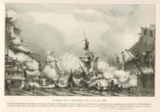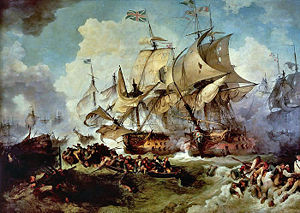
French ship Vengeur du Peuple
Encyclopedia
The Vengeur du Peuple ("Avenger of the People") was a 74 gun ship of the line
Ship of the line
A ship of the line was a type of naval warship constructed from the 17th through the mid-19th century to take part in the naval tactic known as the line of battle, in which two columns of opposing warships would manoeuvre to bring the greatest weight of broadside guns to bear...
of the French Navy
French Navy
The French Navy, officially the Marine nationale and often called La Royale is the maritime arm of the French military. It includes a full range of fighting vessels, from patrol boats to a nuclear powered aircraft carrier and 10 nuclear-powered submarines, four of which are capable of launching...
launched in 1762.
Originally offered by the city of Marseille, and named the Marseillois ("from Marseille"), she saw action during the American War of Independence. In 1778 she fought a single-ship action with HMS Preston
HMS Preston
Three ships of the Royal Navy have borne the name HMS Preston:*HMS Preston was a 40-gun ship launched in 1653 as Preston. She was renamed HMS Antelope in 1660 and was sold in 1693....
, and in 1779 was with Admiral d'Estaing
Charles Hector, comte d'Estaing
Jean Baptiste Charles Henri Hector, comte d'Estaing was a French general, and admiral. He began his service as a soldier in the War of the Austrian Succession, briefly spending time as a prisoner of war of the British during the Seven Years' War...
at the capture of Grenada
Grenada
Grenada is an island country and Commonwealth Realm consisting of the island of Grenada and six smaller islands at the southern end of the Grenadines in the southeastern Caribbean Sea...
. In 1781 she was at the battle of the Chesapeake
Battle of the Chesapeake
The Battle of the Chesapeake, also known as the Battle of the Virginia Capes or simply the Battle of the Capes, was a crucial naval battle in the American War of Independence that took place near the mouth of Chesapeake Bay on 5 September 1781, between a British fleet led by Rear Admiral Sir Thomas...
with Admiral de Grasse, where she battled against HMS Intrepid
HMS Intrepid (1770)
HMS Intrepid was a 64-gun third rate ship of the line of the Royal Navy, launched on 4 December 1770 at Woolwich.In 1772 the Intrepid sailed to the Dutch East Indies...
.
Re-named in 1794 by the French Republic, the Vengeur was part of the French fleet, under Admiral Villaret de Joyeuse, which fought the Third Battle of Ushant. In that action she engaged in an epic four-hour duel with HMS Brunswick
HMS Brunswick (1790)
HMS Brunswick was a 74-gun third rate ship of the line of the Royal Navy, launched on 30 April 1790 at Deptford.On 29 October 1792, three condemned mutineers of the Mutiny on the Bounty were hanged from her yardarms....
. With two masts down and one-third of her crew out of action, and with severe damage below the waterline, the Vengeur sank. 277 men, including her commanding officer, captain Renaudin
Jean François Renaudin
Jean François Renaudin was a French admiral.He joined the Navy at 12 and rose in rank through a number of actions against the British....
, were saved by the British (HMS Alfred
HMS Alfred (1778)
HMS Alfred was a 74-gun third rate ship of the line of the Royal Navy, launched on 22 October 1778 at Chatham.She fought at the Battle of Cape St Vincent in 1780.Alfred was broken up in 1814....
rescued about 100 men; HMS Rattler
HMS Rattler
Eight ships of the Royal Navy have borne the name HMS Rattler:*HMS Rattler was a 16-gun sloop launched in 1783 and sold in 1792.*HMS Rattler was a 16-gun sloop launched in 1795 and sold in 1815....
, about 40; and HMS Culloden
HMS Culloden (1783)
HMS Culloden was a 74-gun third rate ship of the line of the Royal Navy, launched on 16 June 1783 at Rotherhithe. She took part in some of the most famous battles of the French Revolutionary Wars and the Napoleonic Wars....
, 127, including Renaudin).
Propaganda utilisation

National Convention
During the French Revolution, the National Convention or Convention, in France, comprised the constitutional and legislative assembly which sat from 20 September 1792 to 26 October 1795 . It held executive power in France during the first years of the French First Republic...
, that the ship sank with her crew who chose to go down with the ship rather than surrender, shouting "long live the fatherland, long live the republic". The nation was inflamed, and the poet André Chenier
André Chénier
André Marie Chénier was a French poet, associated with the events of the French Revolution of which he was a victim. His sensual, emotive poetry marks him as one of the precursors of the Romantic movement...
composed a eulogy to commemorate the event. In fact close to 400 officers and men were rescued by the enemy, and were released some months later. The rescue is depicted in Lord Howe's action, or the Glorious First of June
Lord Howe's action, or the Glorious First of June
Lord Howe's action, or the Glorious First of June is a 1795 painting by Philippe-Jacques de Loutherbourg of the victory of British naval forces under Lord Howe over a French force led by Louis Thomas Villaret de Joyeuse on the Glorious First of June 1794...
, Loutherbourg's canvas of the battle.
The legend has persisted, however, and Jules Verne
Jules Verne
Jules Gabriel Verne was a French author who pioneered the science fiction genre. He is best known for his novels Twenty Thousand Leagues Under the Sea , A Journey to the Center of the Earth , and Around the World in Eighty Days...
reported the incident with its revolutionary slant, and the ship's early history, in Twenty Thousand Leagues Under The Sea
Twenty Thousand Leagues Under the Sea
Twenty Thousand Leagues Under the Sea is a classic science fiction novel by French writer Jules Verne published in 1870. It tells the story of Captain Nemo and his submarine Nautilus as seen from the perspective of Professor Pierre Aronnax...
.

